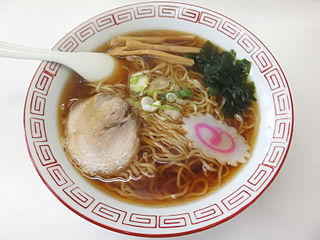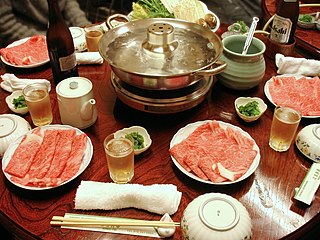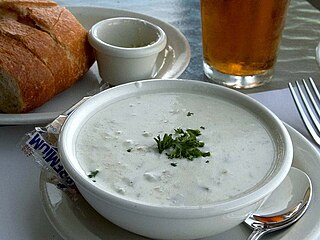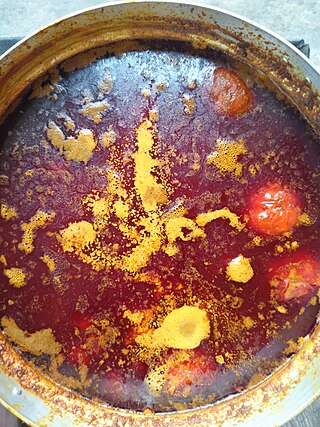
Miso is a traditional Japanese seasoning. It is a thick paste produced by fermenting soybeans with salt and kōji and sometimes rice, barley, seaweed, or other ingredients. It is used for sauces and spreads, pickling vegetables, fish, or meats, and mixing with dashi soup stock to serve as miso soup, a Japanese culinary staple. Miso is high in protein and rich in vitamins and minerals, and it played an important nutritional role in feudal Japan. Miso is still widely used in both traditional and modern cooking in Japan and has been gaining worldwide interest.

Ramen is a Japanese noodle dish. It consists of Chinese-style wheat noodles served in a broth; common flavors are soy sauce and miso, with typical toppings including sliced pork, nori, menma, and scallions. Ramen has its roots in Chinese noodle dishes and is a part of Japanese Chinese cuisine. Nearly every region in Japan has its own variation of ramen, such as the tonkotsu ramen of Kyushu and the miso ramen of Hokkaido.

Sashimi is a Japanese delicacy consisting of fresh raw fish or meat sliced into thin pieces and often eaten with soy sauce.

Miso soup is a traditional Japanese soup consisting of a dashi stock into which softened miso paste is mixed. In addition, there are many optional ingredients that may be added depending on regional and seasonal recipes, and personal preference. In Japanese food culture, miso soup is a representative of soup dishes served with rice. Miso soup is also called omiotsuke (御味御付).

Finnish cuisine is notable for generally combining traditional country fare and haute cuisine with contemporary continental-style cooking. Fish and meat play a prominent role in traditional Finnish dishes in some parts of the country, while the dishes elsewhere have traditionally included various vegetables and mushrooms. Evacuees from Karelia contributed to foods in other parts of Finland in the aftermath of the Continuation War.

Stock, sometimes called bone broth, is a savory cooking liquid that forms the basis of many dishes – particularly soups, stews, and sauces. Making stock involves simmering animal bones, meat, seafood, or vegetables in water or wine, often for an extended period. Mirepoix or other aromatics may be added for more flavor.

Shabu-shabu is a Japanese nabemono hotpot dish of thinly sliced meat and vegetables boiled in water and served with dipping sauces. The term is onomatopoeic, derived from the sound – "swish swish" – emitted when the ingredients are stirred in the cooking pot. The food is cooked piece by piece by the diner at the table. Shabu-shabu is generally more savory and less sweet than sukiyaki, another hot pot dish.

Banmian or pan mee is a popular Chinese noodle dish, consisting of handmade noodles served in soup. Other types of handmade noodles include youmian, or mee hoon kueh.

Ainu cuisine is the cuisine of the ethnic Ainu in Japan and Russia. The cuisine differs markedly from that of the majority Yamato people of Japan. Raw meat like sashimi, for example, is rarely served in Ainu cuisine, which instead uses methods such as boiling, roasting and curing to prepare meat. Also unlike Japanese cuisine, traditional Ainu cuisine did not use miso, soy sauce, or sugar, though these seasonings make an appearance in modern Ainu cuisine. The island of Hokkaidō in northern Japan is where most Ainu live today; however, they once inhabited most of the Kuril islands, the southern half of Sakhalin island, and parts of northern Honshū Island.

Noodle soup refers to a variety of soups with noodles and other ingredients served in a light broth. Noodle soup is a common dish across East Asia, Southeast Asia and the Himalayan states of South Asia. Various types of noodles are used, such as rice noodles, wheat noodles and egg noodles.

Pinakbet is an indigenous Filipino dish from the northern regions of the Philippines. Pinakbet is made with a variety of mixed vegetables flavored with bagoóng. The word is the contracted from the Ilokano word pinakebbet, meaning "shrunk" or "shriveled."

Japanese cuisine has a vast array of regional specialities known as kyōdo ryōri (郷土料理) in Japanese, many of them originating from dishes prepared using local ingredients and traditional recipes.

Tare is a general term in Japanese cuisine for dipping sauces often used in grilling as well as with sushi, nabemono, and gyoza. It can also be used to make the soup for ramen by combining it with stock and/or broth in order to add to the complex combination of flavors, and as a braising liquid for meat.

Fish soup is a food made by combining fish or seafood with vegetables and stock, juice, water, or another liquid. Hot soups are additionally characterized by boiling solid ingredients in liquids in a pot until the flavors are extracted, forming a broth.

Palm nut soup or banga is a soup made from palm fruit common in the Cameroonian, Ghanaian, Nigerian, Democratic Republic of Congo and Ivorian communities. The soup is made from a palm cream or palm nut base with stewed marinated meats, smoked dried fish, and aromatics. It is often eaten with starch, fufu, omotuo, banku, fonio, or rice. The use of the palm fruit in cooking is significant in Ivorian, Cameronian, Nigerian, Ghanaian, Liberian and other West and Central African cuisine.

Hot and sour soup is a popular example of Chinese cuisine. Although it is said to be originated in Sichuan, this is actually a variant of hulatang or "pepper hot soup" (胡辣汤) with added vinegar to enhance the sourness. This variation is found in Henan province, and in Henan cuisine itself. Also popular in Southeast Asia, India, Pakistan and the United States, it is a flexible soup which allows ingredients to be substituted or added depending on availability. For example, the American-Chinese version can be thicker as it commonly includes corn starch, whilst in Japan, sake is often added.

Hot pot or hotpot, also known as steamboat, is a dish whereby a heat source placed on the dining table keeps a pot of soup stock simmering, and accompanied with an array of Chinese foodstuffs and ingredients and food offerings provided for the diners to dip into the flavorful broth.

















